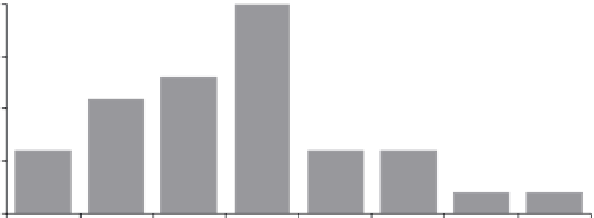Biomedical Engineering Reference
In-Depth Information
20
15
10
5
0
Concentration range
[mg Ag/kg textile]
FIGURE 15.2
Ag concentrations in textile consumer products. bdl: below detection limit.
(Data extracted from Benn, T.M., Westerhoff, P.
Environ. Sci. Technol.,
42, 4133- 4139, 2008;
Geranio, L. et al.,
Environ. Sci. Technol.,
43, 8113-8118, 2009 GSM , 8, 2009; Benn, T. et al.
J. Environ. Quality,
39, 1875-1882, 2010; Kulthong, K. et al.,
Part Fibre Toxicol.
7, 8, 2010;
DEPA (2012), Assessment of nanosilver in textiles on the Danish market, Environmental
Project No. 1432, Copenhagen, Danish Environmental Protection Agency; KEMI (2012),
Antibacterial substances leaking out with the washing water: analyses of silver, triclosan and
triclocarban in textiles before and after washing, Sundbyberg, Swedish Chemicals Agency;
Lorenz, C. et al.,
Chemosphere
89, 817-824, 2012.)
the g/kg range or even in the %-range. Nano-textiles usually have Ag concentrations
that are lower than textiles using conventional Ag or AgCl as biocide (Windler et al.
2013). The designation as “nanotextiles” is based in most cases on the labeling of
the textiles. Analysis of ENM in complex matrices is notoriously difficult (von der
Kammer et al. 2012) and therefore almost no studies have tried to verify the presence
of nanomaterials in the textiles. Most studies about nano-textiles equalize the pres-
ence of Ag in the textiles to the presence of nano-Ag, although this is of course not
correct because many conventional uses of Ag are on the market. Some studies have
used textiles that were directly obtained from companies producing nanomaterials
and first-hand information on the type of materials was obtained.
In Figure 15.3, the main results of the release experiments are compiled. It shows
how much of the total Ag in the textiles is released in the different studies. The stud-
ies mimicking washing conditions report most often releases above 51% of the total
Ag. 64% of all investigated textiles released more than 10% of the Ag in a single
washing. However, 26% of the textiles released less than 1% of silver.
There are less experiments performed in artificial sweat but it seems that lower
amounts of Ag are released into this medium, most often a release below the detec-
tion limit was reported.
Several studies also looked at the characterization of the released materials. Benn
and Westerhoff (2008) showed that in distilled water the majority of the released Ag
was in dissolved form (up to 86%). Geranio et al. (2009) and Lorenz et al. (2012)
found that in washing solution most of the released Ag was present in particulate

Search WWH ::

Custom Search